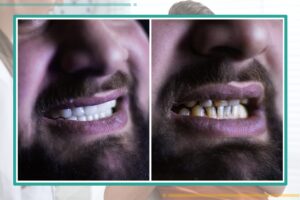Zirconium Bridge
The use of Zirconium Bridge has gained significant attention in recent years due to its exceptional properties and advantages over traditional bridge materials. Zirconium, a biocompatible material with excellent biocompatibility and aesthetic qualities, has emerged as an ideal choice for dental bridges.
Not only does zirconium offer superior strength and durability. But it also provides a natural appearance that closely resembles the color and translucency of natural teeth. Additionally, zirconium bridges are resistant to corrosion, making them highly durable and long-lasting. Moreover, zirconium bridges promote gum health as they have smooth surfaces that prevent plaque buildup and irritation to the gums.
To further enhance the performance and longevity of zirconium bridges, additional measures can be taken. These measures include utilizing non-cytotoxic components such as niobium, molybdenum, tantalum, and zirconium to create a zirconium composite bridge. This composite material, known as Zr-Ti, has been found to be the most promising in terms of biocompatibility and overall performance. With the increasing demand for dental bridges that offer both functionality and aesthetic appeal, zirconium bridges have emerged as a viable solution.
Zirconium bridges not only provide a strong and durable solution for replacing missing teeth. But they also offer exceptional aesthetic qualities that can greatly enhance a patient
Zirconium Crowns Pros and Cons
There are several advantages of using zirconium bridges in dentistry.
- Firstly, zirconium bridges offer excellent strength and durability. They are known for their remarkable resistance to fracture and chipping, making them a reliable long-term solution for replacing missing teeth.
- Secondly, zirconium bridges have exceptional aesthetic qualities. Their natural color and translucency closely mimic that of natural teeth, resulting in a seamless and natural-looking smile.
- Additionally, zirconium bridges are highly biocompatible. It means that they are well-tolerated by the surrounding gum tissue and do not cause irritation or adverse tissue reactions.
- Lastly, zirconium bridges are resistant to corrosion, ensuring their longevity and durability. The use of zirconium bridges in dentistry has revolutionized the field by providing a reliable and aesthetically pleasing solution for replacing missing teeth.
In contrast, there are several reasons why zirconium bridges may not be the ideal option for every patient.
- For example, zirconium bridges can be more expensive than alternative options such as metal or resin bridges. This may limit their accessibility for patients with budgetary constraints.
- In addition, the process of fabricating zirconium bridges can be complex and time-consuming, requiring specialized equipment and expertise.
- Furthermore, zirconium bridges may not be suitable for patients with certain oral conditions or habits. It is important for dentists to thoroughly assess the individual patient’s needs and oral health status before recommending zirconium bridges as a treatment option.
Thus, zirconium bridges offer numerous advantages in terms of biocompatibility, durability, and aesthetics. They provide a strong and natural-looking solution for replacing missing teeth while ensuring long-term functionality and patient satisfaction.
Full Arch Zirconia Implant Bridge
The full arch zirconia implant bridge is a comprehensive dental solution. It provides exceptional strength and durability for patients requiring a full set of replacement teeth. This type of bridge is especially suitable for those who have lost all of their natural teeth and are seeking a permanent and natural-looking alternative.
The full arch zirconia implant bridge is custom-designed to fit the unique shape and structure of the patient’s mouth. It gives a seamless and comfortable fit.
In addition to its superior strength and durability, the full arch zirconia implant bridge offers exceptional aesthetic qualities. Closely resembling the appearance of natural teeth in both color and translucency. This ensures that patients can enjoy a natural-looking smile and enhanced facial aesthetics.
With its biocompatible properties, the full arch zirconia implant bridge promotes gum health. It is well-tolerated by the surrounding oral tissues, minimizing the risk of irritation or adverse reactions. Its smooth surfaces prevent plaque buildup and contribute to overall oral health.
While the process of fabricating a full arch zirconia implant bridge may be more intricate and time-consuming, the long-term benefits in terms of functionality and aesthetics make it a highly desirable option for many patients seeking a permanent solution for replacing their missing teeth. Just like any dental treatment. It`s important for the dentist to carefully assess the patient’s individual needs. Adding to that the oral health status to determine the suitability of the full arch zirconia implant bridge as a treatment option.
Full Zirconia Crown
The process of obtaining a full arch zirconia implant bridge begins with a thorough examination and consultation with a qualified prosthodontist or dentist specializing in implant dentistry. During this initial assessment, the dentist will evaluate the patient’s oral health, bone density, and overall suitability for the procedure. X-rays and possibly dental impressions will be taken to aid in the design and fabrication of the custom full arch zirconia implant bridge.
Following the evaluation, the dentist will surgically place the dental implants into the jawbone. These implants will serve as sturdy anchors for the full arch zirconia bridge. After the surgical placement of the implants, a healing period is necessary to allow the implants to integrate with the surrounding bone tissue.
Once the healing process is complete, the dentist will take impressions of the patient’s mouth to create a precise mold for the fabrication of the zirconia bridge. Advanced digital technologies may be employed to ensure the accuracy of the bridge’s design and fit. The custom-designed zirconia bridge will then be fabricated in a dental laboratory. Therefore, skilled technicians will meticulously craft the prosthetic to meet the patient’s unique specifications.
Further Details
Upon completion of the fabrication process, the zirconia bridge will be fitted and adjusted as needed to ensure proper alignment and bite. The bridge will be securely attached to the previously placed dental implants. It`ll create a stable and natural-looking full arch of replacement teeth.
The patient will receive detailed instructions on post-operative care and maintenance to ensure the long-term success of the full arch zirconia implant bridge. Regular follow-up appointments will be scheduled to monitor the healing process and the functionality of the bridge.
It is essential for the patient to maintain good oral hygiene and attend regular dental check-ups to preserve the health and integrity of the full arch zirconia implant bridge. With proper care, this comprehensive dental solution can provide exceptional strength, aesthetics, and functionality. Thus, it allows patients to enjoy the benefits of a complete and natural-looking smile.
Do you know how long does Nose Lift last?
Cost of Zirconia Bridge
It can vary depending on several factors, including the number of teeth being replaced, the complexity of the case, and the location of the dental practice. Typically, zirconia bridges tend to be more expensive than alternative options. Those are such as metal or resin bridges due to the higher cost of materials and the detailed fabrication process involved.
It’s important for patients to consult with their dentist or prosthodontist to discuss the cost of a zirconia bridge. In addition to any potential financing options that may be available. Some dental offices offer payment plans or financing arrangements to help make the cost of treatment more manageable for patients.
It’s also worth noting that while the initial cost of a zirconia bridge may be higher. The long-term durability and aesthetic benefits of zirconia bridges can make them a worthwhile investment for many patients seeking a reliable and natural-looking solution for replacing missing teeth.

Zirconium Crowns Before and After
Before the placement of zirconium crowns, a thorough examination and consultation with a qualified prosthodontist or dentist specializing in cosmetic dentistry will be necessary. During this initial assessment, the dentist will evaluate the condition of the patient’s existing teeth and the health of the surrounding oral tissues. In addition to the patient’s specific aesthetic goals for the treatment.
The process of obtaining zirconium crowns involves preparing the existing teeth to ensure a proper fit for the crowns. This may involve reshaping the teeth to create space for the crowns and removing any damaged or decayed portions. In some cases, impressions of the teeth will be taken to aid in the design and fabrication of the custom zirconium crowns.
What are the common Types of Weight Loss Surgeries?
Once the teeth are prepared, the dentist will take impressions of the patient’s mouth to create a precise mold for the fabrication of the zirconium crowns. Advanced digital technologies may be employed to ensure the accuracy of the crowns’ design and fit. The custom-designed zirconium crowns will then be fabricated in a dental laboratory. Where skilled technicians will meticulously craft the prosthetics to meet the patient’s unique specifications.
Upon completion of the fabrication process, the zirconium crowns will be fitted and adjusted as needed to ensure proper alignment and bite. The crowns will be securely bonded to the prepared teeth. They`re providing a durable and aesthetically pleasing restoration.
After the placement of the zirconium crowns;
- The patient will receive detailed instructions on post-operative care and maintenance to ensure the long-term success of the treatment.
- It’s important for the patient to maintain good oral hygiene and attend regular dental check-ups to preserve the health and integrity of the zirconium crowns.
- With proper care, zirconium crowns can provide exceptional strength, aesthetics, and functionality, allowing patients to enjoy the benefits of a natural-looking and long-lasting dental restoration.
Future Prospects of Zirconium Crowns in Dentistry
The future prospects of zirconium crowns in dentistry look promising. Research has shown that the use of zirconium crowns can greatly reduce chipping and delamination compared to other materials. This suggests that zirconium crowns may become even more widely adopted in the field of dentistry as professionals continue to seek long-lasting and esthetically pleasing dental restorations.
In addition, ongoing research and development are focused on improving the properties and performance of zirconium crowns. Some potential future developments may include enhancing the bonding techniques for zirconium crowns to further improve their longevity and stability. In conclusion, zirconium crowns offer a promising future in dentistry due to their superior strength, durability, and aesthetic appeal.
Artificial Intelligence is rapidly advancing and has the potential to revolutionize various industries, including healthcare. In the field of dentistry, Artificial Intelligence has the potential to greatly impact and improve patient care and treatment outcomes.
Conclusion: Zirconia Bridge Teeth
In conclusion, zirconium crowns are a popular choice for dental restorations due to their strength, durability, and aesthetic appeal. Additionally, advancements in technology, such as computer-aided design and manufacturing (CAD/CAM). They have greatly improved the precision and efficiency of the fabrication process for zirconium crowns.
As a result, patients can expect a custom-fit and highly accurate restoration that closely resembles their natural teeth. Furthermore, the use of zirconium crowns in dental restorations can also help to avoid common complications such as chipping and delamination. Zirconium crowns are a popular choice for dental restorations due to their strength, durability, and aesthetic appeal.
The Ultimate Guide to Gynecomastia: Causes, Symptoms, and Treatments





